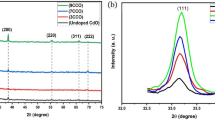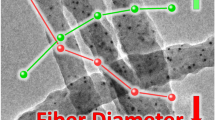Abstract
Among the various possible structural modifications spiropyrans may be subject to, ones containing alkyl sulfonates groups are commonly classified as photoacids. Both alkyl sulfonates spiropyrans named SON and SOH were structurally characterized and their acido- and photochromic properties were studied by UV–visible spectroscopy. Electrospun poly-ε-caprolactone (PCL) fibers were obtained, in which SON or SOH were incorporated with the goal of detecting acid and base vapors. PCL fibers containing the derivatives SON and SOH were successfully obtained (0.8 μm range), capable of acting as colorimetric vapor sensors according to the acidochromic properties of the spiropyrans. PCL-SON fibers presented quick vapor sensing capability, with colorimetric change within 10 s of exposure. Scanning electronic microscopy was crucial to characterize the morphology of these fibers before and after being used in the sensing process. This material could be reversibly reutilized in the sensing of acids and bases vapors according to the results presented.
Graphical abstract
Macroscopic color change for electrospun fibers based on acid or base vapors







Similar content being viewed by others


Data availability
Derived data supporting the findings of this study are available from the corresponding author on request.
References
L. Kortekaas, W.R. Browne, The evolution of spiropyran: fundamentals and progress of an extraordinarily versatile photochrome. Chem. Soc. Rev. 48(12), 3406 (2019)
M. Natali, L. Soldi, S. Giordani, A photoswitchable Zn (II) selective spiropyran-based sensor. Tetrahedron 66(38), 7612 (2010)
F. Khakzad, A.R. Mahdavian, H. Salehi-Mobarakeh, A. Rezaee Shirin-Abadi, M. Cunningham, Redispersible PMMA latex nanoparticles containing spiropyran with photo-, pH- and CO2- responsivity. Polymer (Guild) 101, 274 (2016)
F.B. Miguez, I.F. Reis, L.P. Dutra, I.M.S. Silva, T. Verano-Braga, J.F. Lopes, F.B. De Sousa, Electronic investigation of light-induced reversible coordination of Co(II)/spiropyran complex. Dye. Pigment. 171, 107757 (2019)
V.I. Minkin, Photo-, thermo-, solvato-, and electrochromic spiroheterocyclic compounds. Chem. Rev. 104(5), 2751 (2004)
H. Zhang, Y. Chen, Y. Lin, X. Fang, Y. Xu, Y. Ruan, W. Weng, Spiropyran as a mechanochromic probe in dual cross-linked elastomers. Macromolecules 47(19), 6783 (2014)
M. Bletz, U. Pfeifer-Fukumura, U. Kolb, W. Baumann, Ground-and first-excited-singlet-state electric dipole moments of some photochromic spirobenzopyrans in their spiropyran and merocyanine form. J. Phys. Chem. A 106(10), 2232 (2002)
I. Panaiotov, S. Taneva, A. Bois, F. Rondelez, Photoinduced dilatational motion in monolayers of poly(methyl methacrylate) having benzospiropyran side groups. Macromolecules 24(15), 4250 (1991)
Z. Shi, P. Peng, D. Strohecker, Y. Liao, Long-lived photoacid based upon a photochromic reaction. J. Am. Chem. Soc. 133(37), 14699 (2011)
M. Schnurbus, M. Kabat, E. Jarek, M. Krzan, P. Warszynski, B. Braunschweig, Spiropyran sulfonates for photo- and pH-responsive air-water interfaces and aqueous foam. Langmuir 36(25), 6871 (2020)
C. Berton, D.M. Busiello, S. Zamuner, R. Scopelliti, F. Fadaei-Tirani, K. Severin, C. Pezzato, Light-switchable buffers. Angew. Chemie Int. Ed. 60(40), 21737 (2021)
G. Kocak, C. Tuncer, V. Bütün, PH-responsive polymers. Polym. Chem. 8(1), 144 (2017)
M. Wei, Y. Gao, X. Li, M.J. Serpe, Stimuli-responsive polymers and their applications. Polym. Chem. 8(1), 127 (2017)
M. Sponchioni, U. Capasso Palmiero, D. Moscatelli, Thermo-responsive polymers: applications of smart materials in drug delivery and tissue engineering. Mater. Sci. Eng. C 102, 589 (2019)
S. Pedron, S. Van Lierop, P. Horstman, R. Penterman, D.J. Broer, E. Peeters, Stimuli responsive delivery vehicles for cardiac microtissue transplantation. Adv. Funct. Mater. 21(9), 1624 (2011)
A.S. Hoffman, Stimuli-responsive polymers: biomedical applications and challenges for clinical translation. Adv. Drug Deliv. Rev. 65(1), 10 (2013)
A. Richter, G. Paschew, S. Klatt, J. Lienig, K.F. Arndt, H.J.P. Adler, Review on hydrogel-based pH sensors and microsensors. Sensors 8(1), 561 (2008)
M. Mrinalini, S. Prasanthkumar, Recent advances on stimuli-responsive smart materials and their applications. ChemPlusChem 84(8), 1103 (2019)
F. Arab Hassani, Q. Shi, F. Wen, T. He, A. Haroun, Y. Yang, Y. Feng, C. Lee, Smart materials for smart healthcare—moving from sensors and actuators to self-sustained nanoenergy nanosystems. Smart Mater. Med. 1, 92 (2020)
F.B. De Sousa, F. Alexis, S. Giordani, Editorial: photochromic materials: design and applications. Front. Mater. (2021). https://doi.org/10.3389/fmats.2021.720172
M.E. Genovese, A. Athanassiou, D. Fragouli, Photoactivated acidochromic elastomeric films for on demand acidic vapor sensing. J. Mater. Chem. A 3(44), 22441 (2015)
J. Keyvan Rad, A.R. Ghomi, K. Karimipour, A.R. Mahdavian, Progressive readout platform based on photoswitchable polyacrylic nanofibers containing spiropyran in photopatterning with instant responsivity to acid-base vapors. Macromolecules 53(5), 1613 (2020)
A. Steinegger, O.S. Wolfbeis, S.M. Borisov, Optical sensing and imaging of pH values: spectroscopies, materials, and applications. Chem. Rev. 120(22), 12357 (2020)
R. Avolio, A. Grozdanov, M. Avella, J. Barton, M. Cocca, F. De Falco, A.T. Dimitrov, M.E. Errico, P. Fanjul-Bolado, G. Gentile, P. Paunovic, A. Ribotti, P. Magni, Review of pH sensing materials from macro- to nano-scale: recent developments and examples of seawater applications. Crit. Rev. Environ. Sci. Technol. (2020). https://doi.org/10.1080/10643389.2020.1843312
M.E. Genovese, E. Colusso, M. Colombo, A. Martucci, A. Athanassiou, D. Fragouli, Acidochromic fibrous polymer composites for rapid gas detection. J. Mater. Chem. A 5(1), 339 (2017)
R. Klajn, Spiropyran-based dynamic materials. Chem. Soc. Rev. 43(1), 148 (2014)
S. Huang, K. Wang, S. Wang, Y. Wang, M. Wang, Highly fluorescent polycaprolactones with tunable light emission wavelengths across visible to NIR spectral window. Adv. Mater. Interfaces 3(17), 1600259 (2016)
R.C.L. Machado, F. Alexis, F.B. De Sousa, Nanostructured and photochromic material for environmental detection of metal ions. Molecules 24(23), 4243 (2019)
I.F. Reis, F.B. Miguez, C.A.A. Vargas, T.G. Menzonatto, I.M.S. Silva, T. Verano-Braga, J.F. Lopes, T.A.S. Brandão, F.B. De Sousa, Structural and electronic characterization of a photoresponsive lanthanum(III) complex incorporated into electrospun fibers for phosphate ester catalysis. ACS Appl. Mater. Interfaces. (2020). https://doi.org/10.1021/acsami.0c03571
C. Berton, D.M. Busiello, S. Zamuner, E. Solari, R. Scopelliti, F. Fadaei-Tirani, K. Severin, C. Pezzato, Thermodynamics and kinetics of protonated merocyanine photoacids in water. Chem. Sci. 11(32), 8457 (2020)
D. Lin-Vien, N.B. Colthup, W.G. Fateley, J.G. Grasselli, The handbook of infrared and Raman characteristic frequencies of organic molecules (Elsevier, Amsterdam, 1991), pp. 477–490
A.P. Kotula, C.R. Snyder, K.B. Migler, Determining conformational order and crystallinity in polycaprolactone via Raman spectroscopy. Polymer (Guildf) 117, 1 (2017)
Y. Liao, Design and applications of metastable-state photoacids. Acc. Chem. Res. 50(8), 1956 (2017)
J. Morais de Faria, L. Alkimin Muniz, J.F.Z. Netto, D. Scheres Firak, F.B. De Sousa, F. da Silva Lisboa, Application of a hybrid material formed by layered zinc hydroxide chloride modified with spiropyran in the adsorption of Ca2+ from water. Colloids Surfaces A Physicochem. Eng. Asp. 631, 127738 (2021)
A. Julià-López, J. Hernando, D. Ruiz-Molina, P. González-Monje, J. Sedó, C. Roscini, Temperature-controlled switchable photochromism in solid materials. Angew. Chem. Int. Ed. 55(48), 15044 (2016)
M.C.R. Simões, S.M. Cragg, E. Barbu, F.B. De Sousa, The potential of electrospun poly(methyl methacrylate)/polycaprolactone core–sheath fibers for drug delivery applications. J. Mater. Sci. 54(7), 5712 (2019)
L.M. Jenkins, A.M. Donald, Contact angle measurements on fibers in the environmental scanning electron microscope. Langmuir 15, 7829 (1999)
N. Abeyrathna, Y. Liao, Stability of merocyanine-type photoacids in aqueous solutions. J. Phys. Org. Chem. 30(8), e3664 (2017)
R. Xu, Methods to resolve mobility from electrophoretic laser light scattering measurement. Langmuir 9(11), 2955 (1993)
Acknowledgments
This work was supported by CNPq (Grant Nos. 431133/2018-2; 437418/2018-9; 308278/2020-8; 309720/2020-6 and scholarship 157706/2019-2) and FAPEMIG (Grant Nos. APQ-01293-14; APQ 02052/21 and APQ-00210-21) and FINEP (CT-INFRA 01/2013-REF 0633/13). This work was also supported by Biosmart Nanotechnology Ltda agreement with UNIFEI (process number 23088.015061/2019-72). Authors would like to thank LIPq-LAREMAR facilities from Department of Chemistry from UFMG for NMR support.
Author information
Authors and Affiliations
Corresponding author
Ethics declarations
Conflict of interest
The authors declare that they have no conflict of interest.
Additional information
Publisher's Note
Springer Nature remains neutral with regard to jurisdictional claims in published maps and institutional affiliations.
Supplementary Information
Below is the link to the electronic supplementary material.
Supplementary file2 (MPEG 16848 KB) Movie S1 Reversibility acid and base vapors detection for PCL-SON
Supplementary file3 (MPEG 26044 KB) Movie S2 Reversibility acid and base vapors detection for PCL-SOH
Rights and permissions
Springer Nature or its licensor (e.g. a society or other partner) holds exclusive rights to this article under a publishing agreement with the author(s) or other rightsholder(s); author self-archiving of the accepted manuscript version of this article is solely governed by the terms of such publishing agreement and applicable law.
About this article
Cite this article
Miguez, F.B., Moreira, O.B.O., de Oliveira, M.A.L. et al. Reversible electrospun fibers containing spiropyran for acid and base vapor sensing. Journal of Materials Research 38, 547–556 (2023). https://doi.org/10.1557/s43578-022-00842-5
Received:
Accepted:
Published:
Issue Date:
DOI: https://doi.org/10.1557/s43578-022-00842-5


